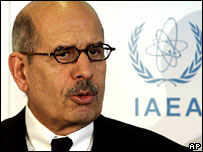Although the latest IAEA report on Iran stated that Tehran had made progress in revealing the extent of its nuclear program, pressure from the United States and its allies for more sanctions continues.
But according to an article on the BBC, the unity of the UN Security Council is wearing thin and the international front against Iran could split, with veto-wielding UN members Russia and China becoming increasingly unwilling to take significant steps against the Islamic Republic.
According to the Vienna-based UN nuclear watchdog, Iran had made important steps towards explaining its past activities, including an admission that it went onto the black market to acquire uranium enrichment technology.
But the IAEA said that Iran failed to suspend the construction of a heavy water reactor, as demanded by the Security Council, and didn’t implement a more intrusive inspection system as agreed before.
It also said that Tehran is resisting UN demands to halt uranium enrichment, a process to make fuel for power plants or nuclear bombs - depending on the level of enrichment.
According to the report, Iran had installed 2952 centrifuges, the machines that do the enriching. Some observers consider the 3000 figure a "red line" because it could facilitate the development of a nuclear bomb in a year or so.
However, the enrichment facility at Natanz is under IAEA inspection and it would be impossible for Iran to do this secretly. If it decided to do this publicly, it would have to leave the nuclear non-proliferation treaty and expose itself to very serious consequences.
The IAEA report raised mixed reactions. While the U.S. -- which accuses the Islamic Republic of seeking to develop nuclear bombs -- dismissed the findings, Iran -- which insists that their nuclear program is aimed at generating electricity -- considered the report a “political victory”.
According to AFP, the U.S. said that Thursday's report showed that Tehran is still defying the international community and that Washington would proceed with its allies to draft broader United Nations sanctions against it.
On other hand, Iranian officials said their country had been vindicated by the IAEA report, and that further discussions at the UN Security Council about the nuclear standoff would have no legal basis.
President Mahmoud Ahmadinejad even "urged the West to bravely apologize to the Iranian nation," following the report, AFP reported.
More sanctions?
The IAEA report is expected to be considered by the five permanent members of the Security Council - the U.S., Russia, China, Britain and France - plus Germany on Monday, but China has not agreed to this date. The IAEA board meets on 22 November.
The EU's foreign policy chief Javier Solana is also expected to file a key report on Iran that would be considered by the Council before it decides whether to slap a third round of sanctions against Tehran.
The question then will be whether Russia and China will agree on more sanctions.
Moscow has recently declared that there’s no evidence that Iran is seeking atomic weapons. Beijing, which has extensive oil and gas contracts with Iran, is also reluctant to act because its economic ties with Tehran might be affected.
If the Security Council doesn’t agree on another sanctions resolution against Iran, then the European Union -- pressed by the UK and France -- could impose sanctions of its own, like the United States, which already imposes wide-ranging sanctions on the Islamic Republic.
British Prime Minister Gordon Brown has proposed that the EU sanctions involve banning investment in Iran’s oil and gas sectors, and financial measures, mainly the restriction of export credits for exports to Iran.
Military action?
Another question beyond sanctions is whether the U.S. will attack Iran. Washington is already being pressured to confront Iran by Israel, which is getting increasingly restless about the failure of sanctions to force Iran to abandon its nuclear program.
In addition to striking Tehran’s nuclear sites, other targets include Iran's ballistic missile sites, naval warfare assets that Tehran could use in a retaliatory closure of the Straits of Hormuz; a vital artery for the flow of Gulf oil, and the Revolutionary Guards, which Washington recently designated as a “terrorist organization“.
The U.S. Navy already has an aircraft carrier in the Persian Gulf area with about 60 fighters and other aircraft that likely would feature prominently in a bombing campaign. A contingent of about 2,200 Marines are on a standard deployment to the Gulf region aboard ships led by the USS Kearsarge, an amphibious assault ship. Moreover, Air Force fighters and bombers are available elsewhere in the Gulf area, including a variety of warplanes in Iraq and at a regional air operations center in Qatar.
Although no strike appears imminent, American defense officials have signaled that up-to-date attack plans against Iran are available if needed. White House officials have also stepped up their rhetoric against Tehran recently.
Vice President Dick Cheney stated on Oct. 21 that the United States would "not allow Iran to have a nuclear weapon," and that Iran would face "serious consequences" if it continued in that direction.
President Bush also suggested on Oct. 17 that Iran's continued pursuit of nuclear arms could lead to "World War III."
Only time will tell whether the U.S. would choose the diplomatic path, and probably impose more sanctions against Iran, or decide to launch another devastating war in an already troubled region.
PHOTO CAPTION
IAEA head Mohamed ElBaradei


 Home
Home Discover Islam
Discover Islam Quran Recitations
Quran Recitations Lectures
Lectures
 Fatwa
Fatwa Articles
Articles Fiqh
Fiqh E-Books
E-Books Boys & Girls
Boys & Girls  Articles
Articles










